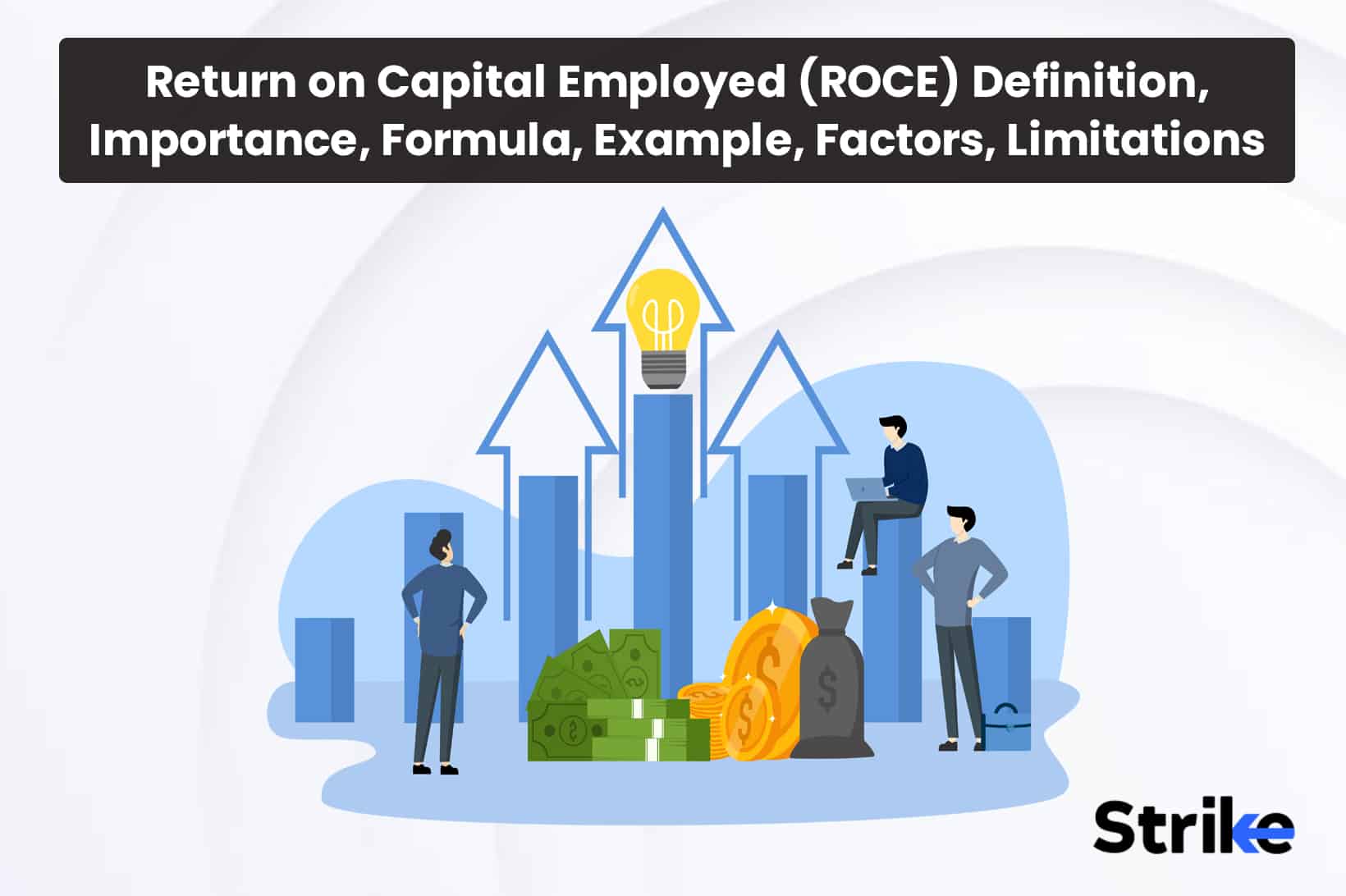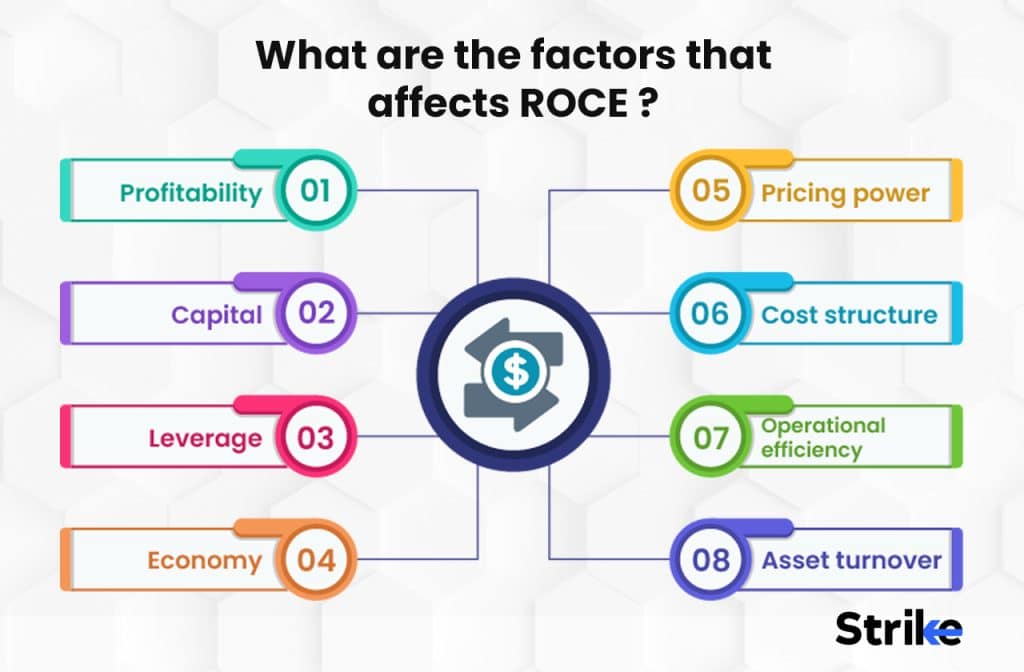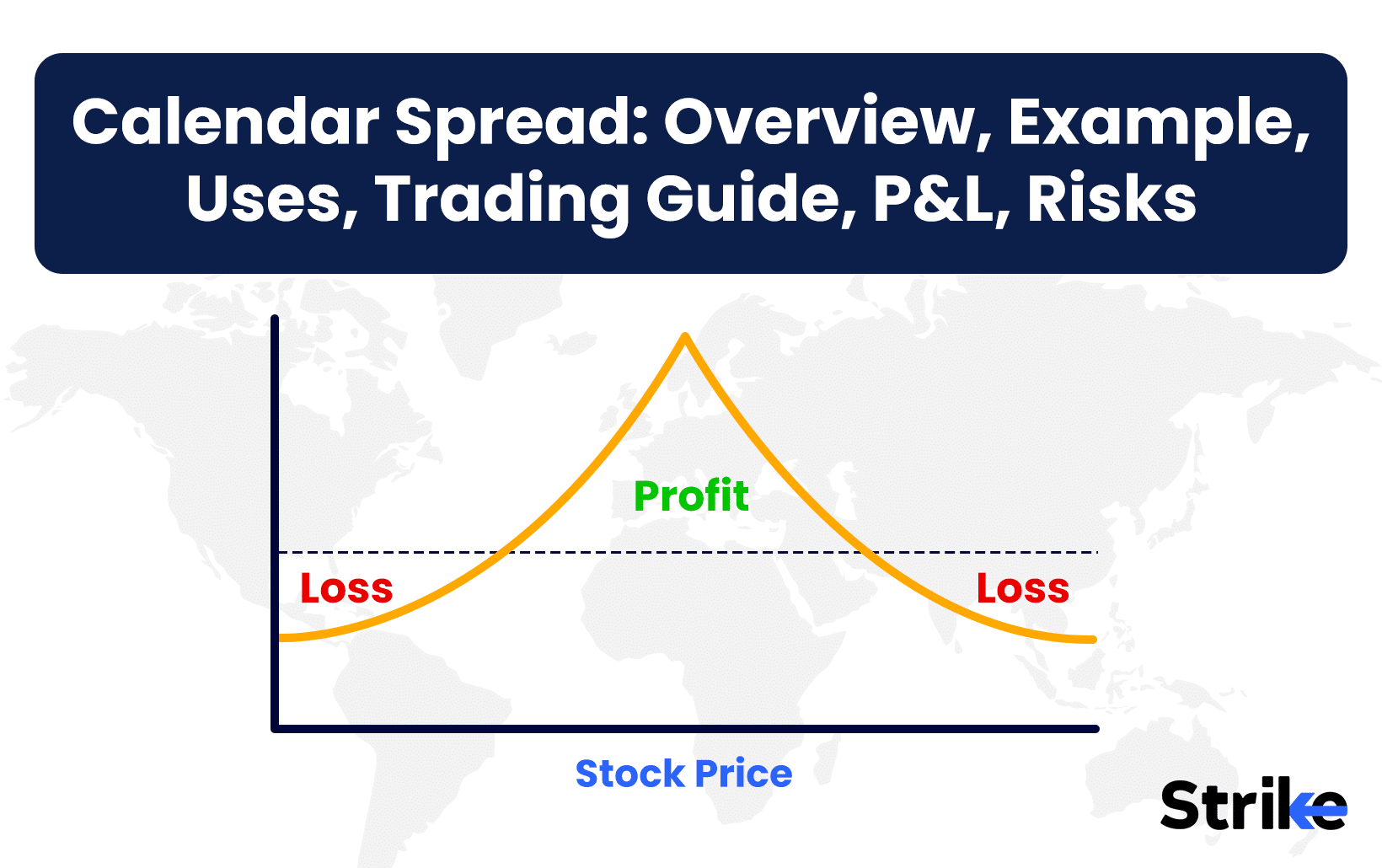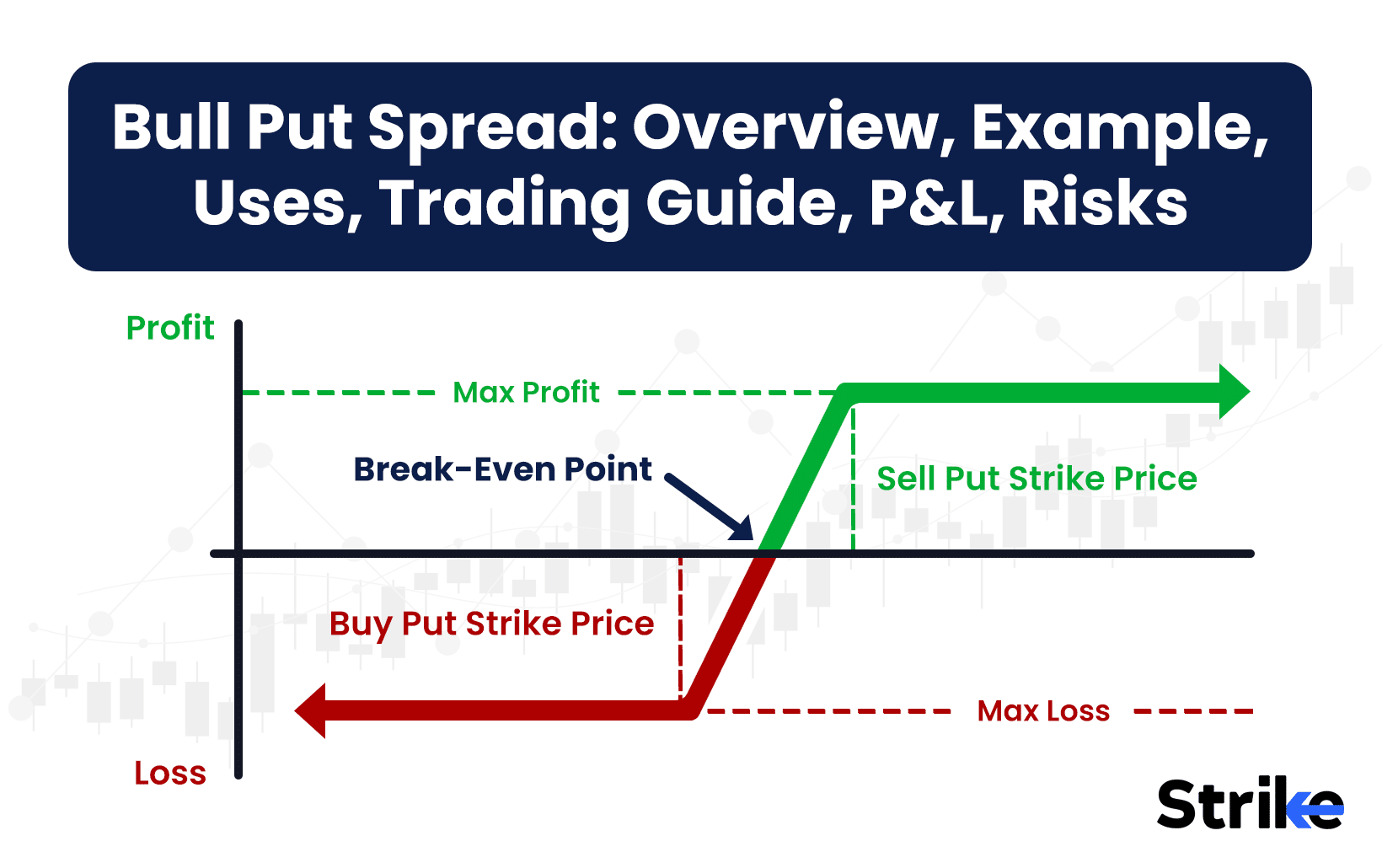Return on Capital Employed (ROCE): Definition, Importance, Formula, Example, Factors, Limitations

Return on Capital Employed (ROCE) is a key financial metric used by investors to evaluate a company’s capital efficiency and profitability. ROCE measures how effectively a company generates earnings from the capital it uses in its business operations, which includes equity, debt, and working capital. It is calculated by dividing a company’s operating profit by its capital employed.
ROCE gives insights into management’s ability to deploy capital into investments that earn returns above the company’s cost of capital. A high and sustained ROCE indicates strong operational performance and capital allocation skills. It signals a company is productively converting its invested funds into profits. In contrast, a low or declining ROCE shows capital is not being optimally utilized to generate adequate returns.
For investors, analyzing ROCE trends over time and comparing them to industry peers provides valuable perspectives. Rising ROCE signifies improving capital efficiency as assets are channeled into more lucrative opportunities. However, declines in ROCE could point to factors like waning competitive advantages or incorrect investment decisions. Benchmarking versus competitors highlights relatively better or worse profit generation from invested funds.
What is the return on capital employed (ROCE)?
Return on capital employed (ROCE) is a financial ratio that measures a company’s profitability and capital efficiency. ROCE is calculated by dividing a company’s earnings before interest and taxes (EBIT) by its capital employed. Capital employed refers to the total capital that a company uses in its operations, which includes both debt and equity. ROCE shows how efficiently a company is using its capital to generate profits. A high ROCE indicates that a company is generating substantial profits from its capital base.
This signals that the company is investing its capital wisely and is deploying assets efficiently to produce returns. A low ROCE, on the other hand, means that a company is not utilizing its capital effectively to earn profits.ROCE is an important ratio that investors use to analyze and compare companies. It provides insight into how well a company is managing its capital and whether its investments are profitable. Investors prefer companies with a consistently high ROCE as it suggests the company has a sustainable competitive advantage in efficiently allocating capital into profitable investments.
Why is ROCE important to understand?
ROCE is important to understand as it evaluates a company’s profit generation capacity relative to the capital it has invested. A high ROCE indicates the company is earning substantial profits using its capital base efficiently. This signals adept capital allocation into productive investments that drive returns. Conversely, a low ROCE implies the invested capital is not generating adequate profits commensurate with the scale of investment.
For investors, high ROCE companies warrant attention as profitability and margins are directly augmented. ROCE matters as it assesses how well management channels capital into avenues that create value. Companies that consistently earn a high ROCE exhibit financial discipline in allocating capital into projects and assets that provide optimal risk-adjusted returns. This underscores management’s strategic astuteness and capital allocation skills. It creates shareholder value as capital gets invested into productive channels rather than wasted on unprofitable ventures. Hence, ROCE offers clues into the financial prudency of the management team.ROCE is relevant as it gauges how efficiently a company’s resources are being utilized to extract returns. High ROCE firms convert a greater share of inputs like fixed assets, working capital, and employees into profitable outputs.
They operate as leaner organizations with a tighter grip on costs. This efficiency flows through into stronger margins and earnings growth. Investors stand to benefit from identifying stocks with superior ROCE, as it highlights operational excellence. ROCE should be understood as it enables comparison between industry peers. A company earning a higher ROCE versus competitors has an edge in productively deploying capital and generating excess returns. This highlights Execution capabilities and potential to gain market share. Investors pinpoint probable outperformers using ROCE as a yardstick for cross-industry analysis.
What is the formula for ROCE?
The Return on Capital Employed (ROCE) ratio measures how efficiently a company uses its capital to generate profits.
ROCE = Earnings Before Interest and Taxes (EBIT) / Capital Employed
Where,
EBIT is the company’s operating profit before accounting for interest and taxes. It gives a sense of the company’s profitability from its core operations.
Capital Employed is the total capital that the company has invested in its operations. It is calculated as shareholder equity plus debt liabilities.
A higher ROCE indicates the company needs less capital to generate its profits. This signals effective management and often correlates with higher stock returns over time. Evaluating ROCE trends over time and comparing them across companies in the same industry provides insight into relative operating efficiency and capital allocation skills.
What is an example of ROCE calculation?
ITC Limited is a diversified Indian conglomerate with interests in fast-moving consumer goods, hotels, paperboards, and packaging. To calculate the company’s return on capital employed (ROCE) for the financial year 2022-2023, we use the following financial data:
Earnings before interest and taxes (EBIT) for the year was Rs. 15,549 crore. Capital employed, calculated as total assets minus current liabilities, was Rs. 49,505 crore.
To calculate ROCE, we divide the EBIT by the capital employed. For ITC Limited
ROCE = EBIT / Capital Employed
= Rs. 15,549 crore / Rs. 49,505 crore
= Approximately 31.41%
A ROCE of 31.41% indicates that for every Rs. 100 of capital employed, ITC Limited generated Rs. 31.41 in profits during the financial year. This is generally considered a high ROCE, suggesting that the company is effectively utilizing its capital to generate profits. Therefore, ITC Limited’s ROCE for FY2022-2023 reflects the efficient use of capital to deliver strong returns.
Where can I find the ROCE of a company?
The annual financial statements and reports of a company, accessible through platforms like Strike.Money, include the ROCE (Return on Capital Employed). These reports, vital for investors examining potential stocks, provide a comprehensive overview of the company’s yearly performance. Within these statements, alongside other crucial profitability metrics such as return on assets and profit margins, investors can find the ROCE figure. These indicators are instrumental in assessing the efficiency of the company’s profit generation from its capital and assets.
What are the factors that affect ROCE?
The key factors that affect ROCE are profitability, capital, leverage, economy, pricing power, cost structure, operational efficiency, and asset turnover. Companies can improve their ROCE by increasing profits relative to sales through operating efficiency and cost controls. Optimizing assets by generating more sales revenue per dollar of assets also boosts ROCE.

1.Profitability
Profitability is a crucial factor determining return on capital employed (ROCE). Publicly traded companies aim to maximize profits to deliver strong returns to shareholders. More profitable companies with higher profit margins tend to have higher ROCE. Investors analyzing stocks look closely at metrics like net income, EPS, operating margins, etc., to gauge profitability. Companies with sustained high profitability tend to have efficient operations, strong brands, pricing power, innovation, and good cost management.
As profits rise, companies reinvest to grow while returning more capital to shareholders. Markets reward consistently profitable companies with higher valuations and premium stock prices, leading to superior shareholder returns over time. Profitability enables firms to generate consistently high ROCE even as they continue to invest in growing their businesses. Thus, improving profitability is a key focus area for companies to maintain high ROCE and create shareholder value.
2. Capital
The amount of capital employed is a key determinant of return on capital employed (ROCE). Investors look at how efficiently companies utilize their invested capital to generate returns. Companies that are capital-intensive, like manufacturers, require large investments in plants, machinery, and inventory. Their ROCE depends on how much revenue and profit they generate per dollar of invested capital. Companies with lower capital intensity, like technology and services firms, don’t need large capital investments.
They achieve higher ROCE with lower capital bases. Markets favor companies that require less capital to fund growth and produce higher returns on invested capital. Companies enhance their ROCE by optimizing capital allocation, divesting non-core assets, improving working capital management, and adopting asset-light business models. Judicious use of capital is critical for delivering higher ROCE and creating shareholder value over the long term.
3. Leverage
Financial leverage, measured by the debt-to-equity ratio, significantly impacts a company’s return on capital employed (ROCE). Investors closely monitor leverage when analyzing stocks, as high debt levels either enhance or diminish ROCE. Judicious use of debt magnifies ROCE by funding growth without requiring additional shareholder equity. However, excessive debt is risky if business slows and cash flows decline, leading to an inability to service debt obligations.
Markets tend to reward companies that use leverage prudently to boost ROCE, have strong cash flows to service debt, and maintain balance sheet flexibility. Conversely, highly leveraged companies see stock underperformance due to concerns about default risk or dilution from capital raises. Companies optimize their cost of capital by maintaining an optimal capital structure. Using leverage strategically at low costs allows companies to increase ROCE and maximize shareholder returns over time.
4. Economy
The overall state of the economy significantly influences a company’s ability to generate return on capital employed (ROCE). During economic expansions, strong consumer spending and business investment tend to improve profitability and asset turnover for companies, lifting ROCE. Investors favor stocks of firms that grow earnings even in slowing economies due to pricing power, cost efficiency, and high margins.
On the other hand, economic recessions or industry downturns strain company profits and ROCE due to low demand, excess capacity, and high fixed costs. Investors become risk-averse during downturns and prefer defensive stocks with resilience to macroeconomics. Companies that maintain high ROCE across business cycles tend to be market leaders and deliver consistent shareholder returns. Adapting operations and finances to economic conditions allows firms to optimize ROCE and capital allocation through varied environments.
5. Pricing power
A company’s ability to influence the pricing of its products and services has a direct impact on its profitability and return on capital employed (ROCE). Firms with strong brands and competitive differentiation raise prices to drive higher earnings, even as costs rise. Investors favor companies with the pricing power to pass on cost inflation without hurting demand. Pricing power allows firms to protect margins, gain market share, and deliver consistent ROCE over time.
Technology platforms, consumer giants, pharmaceutical firms, and industrial leaders often benefit from pricing power advantages that competitors lack. Markets typically reward these companies with premium valuations, given their ability to drive high ROCE. Losing pricing power due to disruption, competition, or regulation rapidly erodes profits and ROCE. Companies focused on building competitive moats and branding to achieve greater pricing flexibility improve their ROCE and shareholder value.
6. Cost structure
The cost structure of a company plays a key role in determining profit margins and return on capital employed (ROCE). Companies with lean operations, efficient production, procurement savings, and tight overhead control tend to have lower costs relative to revenue. This allows them to achieve higher profitability and greater ROCE compared to competitors.
Investors view firms with flexible cost structures favorably, as they potentially maintain margins and ROCE during times of rising input costs or slowing demand. Markets reward companies focused on improving productivity, eliminating waste, optimizing supply chains, and leveraging technology to drive structural cost advantages. Managing operating costs and minimizing capital investments needed to support growth gives companies the potential for superior ROCE. Keeping costs low enables firms to convert a higher proportion of revenues into profits and returns for shareholders.
7. Operational efficiency
The efficiency of a company’s operations directly impacts its profitability and return on capital employed (ROCE). Firms that maximize output and minimize waste from manufacturing, distribution, and administration require lower capital investment to generate each unit of profit. Investors favor companies with lean operations, smooth logistics, and productive workforces that deliver higher asset turnover and greater returns on invested capital.
Markets typically reward operationally efficient firms with premium valuations, given their potential to expand margins and ROCE. Utilizing automation, high-quality processes, and technology to boost reliability, speed, and productivity improves operational efficiency. Companies focused on continuous improvement and optimizing resource usage achieve structural advantages in converting sales into profits, driving superior ROCE and shareholder returns over time. Lean, efficient operations are a competitive necessity for firms aiming to maximize their return on capital employed.
8. Asset turnover
A company’s effectiveness in generating sales from its asset base directly impacts the return on capital employed (ROCE). Companies that produce higher revenues relative to fixed assets like plants and equipment tend to have higher asset turnover and ROCE. Investors favor firms that don’t require large investments in property, plants, and inventory to support sales growth. Asset-light business models, including technology, services, and brands, achieve higher turnover and ROCE than capital-intensive manufacturers.
Markets typically reward asset-efficient firms with strong turnover ratios through higher valuations. Companies improve their ROCE by optimizing production to maximize utilization, simplifying logistics to reduce working capital needs, and leveraging partnerships to stay asset-light. Pursuing strategies that minimize capital requirements while boosting revenues allows companies to enhance asset turnover and deliver higher returns on capital employed.
What is a good ROCE?
As a general guideline, an ROCE consistently above 15% is considered solid in most industries. Over 20% is typically seen as very good, demonstrating efficient use of capital to earn high returns. Below 10%, and capital is yielding lackluster returns. However, these thresholds vary significantly across sectors. The key is to evaluate the durability of returns and whether ROCE has a favorable trend over several years.
Can ROCE be negative?
Yes, ROCE is sometimes negative. This occurs when a company’s net operating profit after tax is negative, meaning it is losing money. A negative ROCE indicates inefficient use of capital and an unprofitable business. It is a sign of poor financial performance and a major red flag for investors evaluating a company.
What does a positive ROCE indicate?
A positive ROCE indicates that a company is efficiently utilizing its capital resources and generating excess returns over its cost of capital. In the stock market context, a high and stable ROCE is viewed very favorably by investors as it demonstrates the company’s strong competitive position and effective management strategy. It signals that the business has robust fundamentals to deliver profitable growth consistently.
Specifically, a high positive ROCE shows that the company is able to earn attractive returns on the capital deployed in its operations. The numerators of the ROCE ratio are metrics like operating income or EBITDA, which represent the company’s core earning power. The denominator of capital employed signifies how much net capital is invested in the business operations. A positive and rising ROCE trend implies that the company is progressively enhancing its earning power while judiciously managing its capital investments.
For capital-intensive industries, ROCE is a particularly important metric. Industries like manufacturing, oil & gas, metals & mining, etc, require huge investments in fixed assets and working capital. A strong ROCE indicates the company’s success in generating adequate returns on such large capital outlays. It shows efficient use of production capacities, optimal utilization of resources, effective cost controls, and strong pricing power. A rising ROCE trend also suggests that prior capital investments by the company have been prudent and value-accretive.
A high ROCE also indicates a company possesses durable competitive advantages versus peers. These could be in the form of proprietary technology, brand reputation, distribution muscle, economies of scale, captive raw material sources, or high customer switching costs. Such advantages act as entry barriers and enable the company to earn excess returns on capital invested. ROCE is significantly above industry averages and highlights such competitive strengths.
What causes ROCE to increase?
The causes for ROCE to increase are increasing net profit margin, asset turnover, or operational efficiency, which improve profitability relative to the capital invested in the company. At a high level, ROCE (return on capital employed) measures how efficiently a company is using its capital to generate profits. Thus, anything that allows a company to generate higher profits relative to the capital employed will increase ROCE.
One of the components of ROCE is operating margin, which measures operating profit as a percentage of revenue. A company increasing its operating margin, all else being equal, leads to an increase in ROCE as well. There are various ways companies improve operating margins, such as reducing COGS through more efficient manufacturing, cutting other operating expenses like R&D or SG&A via process improvements, increasing productivity to get more output per employee, or raising prices. Operating leverage also plays a role – companies with high fixed costs and low variable costs see faster margin expansion as revenue rises.
The other component of ROCE is asset turnover, which measures how much revenue a company generates per dollar of assets. Asset turnover rises if a company generates more sales without needing to increase assets by an equivalent amount. This happens if a company finds ways to improve inventory management, collect accounts receivable faster, or increase sales productivity. Higher asset turnover directly increases ROCE if the operating margin stays constant.
How can a company improve its ROCE?
A company improves its ROCE by focusing on strategies that increase profitability and improve capital efficiency. The main drivers of ROCE are operating profit margin, asset turnover ratio, and financial leverage. By improving these metrics through various initiatives, companies achieve a higher ROCE.
To start with, companies improve their operating profit margin by implementing cost control measures. This includes reducing direct material costs through negotiated supplier discounts, improving inventory management to lower carrying costs, minimizing wastages in production through lean manufacturing techniques, and optimizing staffing to reduce labor costs. Companies also improve gross margins by raising prices judiciously when raw material or wage inflation occurs.
Higher capacity utilization and operating efficiency will lead to lower fixed costs per unit, further improving operating margins. Another effective strategy is to grow revenue faster than costs. Companies identify new high-margin products and services to generate more profitable sales. Expanding into new markets and distribution channels also provides revenue growth opportunities. Higher sales volumes allow companies to spread fixed costs over a larger base, boosting operating margins. Marketing and advertising play a key role in driving profitable revenue growth.
Why does ROCE change with business cycles?
ROCE changes with business cycles as the drivers of profitability and asset turnover are heavily influenced by macroeconomic conditions. During periods of economic expansion, ROCE tends to improve as companies experience rising demand, higher capacity utilization, and increased pricing power. In downturns and recessions, weaker sales, surplus capacity, and competitive pressures cause ROCE to decline. Understanding these cyclical dynamics provides insight into a company’s performance for stock analysts and investors.
In the growth phase of a business cycle, accelerating demand allows companies to increase production and gain operating leverage. With higher volumes spreading fixed costs more thinly, operating profit margins improve. Companies also benefit from improving capacity utilization as idle assets are pressed into production. This boosts asset turnover and efficiently converts assets into revenues. As utilization nears full capacity, companies regain pricing power. With demand outpacing supply across the industry, they raise prices while still sustaining volume growth. This combination of higher prices and volumes further enhances profitability.
With strong sales growth and margins, operating income increases at a faster pace than the asset base. Since ROCE equals operating income divided by capital employed, this results in an expanding ROCE during economic upturns. Companies accelerate capital investment to meet growing demand. But if they maintain discipline and invest only in projects clearing their hurdle rates, this expansion is accretive to overall returns on capital.
In contrast, during recessions, falling demand leads to underutilized capacity, compressed margins, and declining asset turnover. Lower sales revenues combined with sticky fixed costs—like production overheads and depreciation—drag down profitability. To drive volume during downturns, companies often resort to discounting and price cuts. This leads to lower revenue per unit, exacerbating margin pressures.
With softened demand, companies delay or cancel new capital investments and projects. However, existing assets remain underutilized as volume declines. The under-absorption of fixed overhead costs on this excess capacity further reduces margins. Lower production leads to lower turnover of property, plant, and equipment as well. The decline in profitability and asset turnover causes ROCE to dip during recessions.
What are the limitations of ROCE?
The key limitations of ROCE include distortion from intangible assets, failure to account for equity capital costs, inability to compare across industries, distortion from capital spending fluctuations, exclusion of off-balance sheet leases, and potential manipulation using accounting policies.
One key limitation stems from ROCE being based on accounting profits rather than cash flows. Since accounting rules allow substantial discretion in how profits are measured, ROCE is manipulated through accounting policies. For example, conservatively increasing depreciation expense decreases net income and lowers ROCE. Management artificially boosts ROCE by opting for faster inventory costing methods like LIFO, increasing capitalization of expenses, or relaxing reserve accounts like bad debt provisions. Comparing ROCE across firms requires normalizing earnings to exclude distortion from different accounting treatments.
Another limitation arises from the use of total capital employed in the denominator. This aims to capture operating capital tied up in assets. However, balance sheet capital is impacted by subjective asset valuations, off-balance sheet financing like operating leases, and by how many intangible assets a company books during acquisitions. Two firms have identical tangible operating capital while reporting vastly different total capital due to intangibles or hidden lease obligations. This makes comparing their ROCE metrics less informative for stock research.
The varying capital intensity of different industries also limits the use of ROCE to compare companies across sectors. Firms in manufacturing, transportation, and oil & gas require large investments in production equipment, vehicles, drilling rigs, and other fixed assets to operate. Their ROCE will be lower than less capital-intensive services businesses due to higher capital employed, even if profitability is similar. Comparing ROCE performance to industry averages is more relevant for stock analysis than broader cross-sector comparisons.
Timing issues also distort ROCE when used for stock valuation. ROCE will decrease if a company makes major capital investments in new plants, technology, or other projects as capital employed rises before benefits are realized. By contrast, ROCE improves if capital spending is cut back. These fluctuations make long-term ROCE trends more insightful than short-term changes for stock research. Comparing average ROCE over a full industry cycle provides a better indicator of management capital allocation skills.
Debt levels influence ROCE, but equity investors must also consider financial risk. A company leverages up to lower its capital base and increase ROCE. However, higher debt burdens hurt shareholders through increased interest costs and bankruptcy risk. To properly evaluate stocks, ROCE needs to be assessed alongside net debt/equity ratios, interest coverage, and credit ratings. Firms should optimize capital structure, not just maximize ROCE.
What is the difference between ROCE & ROIC?
Return on Capital Employed (ROCE) and Return on Invested Capital (ROIC) are both profitability ratios used by investors to evaluate how efficiently a company generates profits from its capital. While often used interchangeably, ROCE and ROIC have some key differences that impact their suitability for stock research and valuation. Understanding when to apply each metric provides a more complete picture of management effectiveness for equity analysis.
The main difference between ROCE and ROIC lies in their denominators. ROCE divides net operating profit by total capital employed, which includes working capital and fixed assets. ROIC divides net operating profit after tax by just invested capital, excluding working capital. ROIC focuses on returns from invested long-term capital like property, plants, and equipment. ROCE considers returns on the sum of short and long-term capital.
ROIC provides a purer measure of how well a company invests funds into operating assets and uses them to drive profits. Excluding working capital means ROIC cannot be inflated by aggressive working capital management to reduce the denominator. However, ROCE better captures the total capital that management must allocate effectively across all parts of the business. ROCE and ROIC provide a more complete picture than using either ratio alone when used together.
Turning to the numerators, ROCE uses net operating profit before interest and taxes (NOPBT). ROIC uses net operating profit after tax (NOPAT). Tax impacts vary significantly depending on jurisdiction, tax credits, losses, and other factors. For comparing firms’ operating efficiency, NOPAT used in ROIC provides a more consistent measure by excluding tax distortions on profit. But ROCE’s NOPAT aligns with return expectations from debt holders who care about pre-tax profits to service interest costs.
ROIC adjusted for uniform tax rates facilitates peer comparisons and analysis of true operating returns on invested capital. ROCE reveals how profitable a company’s total operations are regardless of tax optimization strategies. As with the denominators, utilizing both metrics together provides advantages over relying on just one.
In terms of capital structure effects, ROIC is better for comparing companies with differing levels of debt and interest costs. ROCE will increase with greater leverage as debt reduces capital employed. But higher debt also increases risk. ROIC excludes interest expense and is unaffected by capital structure choices. While evaluating stocks, ROIC reveals operational efficiencies independent of capital structure decisions.
However, ROCE has merits in showing overall capital allocation and financing optimization abilities. Companies with the highest ROICs do not necessarily make the best investments and financing decisions. Assessing capital structure choices requires analyzing ROCE trends alongside debt ratios and credit risk. Used properly, ROCE improves stock analysis, though distortion from leverage requires consideration.
Is ROCE more important than ROE?
No, ROCE is not necessarily more important than ROE for evaluating a company’s stock performance and potential. Both return on capital employed (ROCE) and return on equity (ROE) are useful metrics, but they measure different things and have varying relevance depending on the company and industry. ROCE measures how efficiently a company uses its capital – both debt and equity – to generate earnings. It indicates how much profit a company earns relative to its capital investments. A higher ROCE generally indicates efficient use of capital. However, ROCE is distorted by leverage since it considers both equity and debt financing. Companies that take on more debt will tend to have higher ROCEs.
Is ROCE a reliable financial ratio?
No, ROCE is not always a reliable financial ratio, especially when evaluating stocks. While return on capital employed (ROCE) provides useful insights, it has some limitations that make it an unreliable metric on its own for stock analysis. The main problem with using ROCE for stock analysis is that it is distorted by financial leverage. ROCE measures returns on all capital invested, including both equity and debt. Companies that take on higher debt levels will show inflated ROCE figures since borrowed money boosts returns if invested profitably. This obscures the true operating efficiency of the business. The high returns rely heavily on debt financing rather than strong core performance.
How can ROCE help in fundamental analysis?
Return on capital employed (ROCE) is an important financial ratio used in fundamental analysis to evaluate the profitability and capital efficiency of a company. It measures how well a company is generating profits from its capital employed, which includes shareholder equity and debt liabilities. By analyzing ROCE over time and comparing it to competitors or industry averages, investors gain insights into the financial health and valuation of a stock.
ROCE shows how much profit a company earns on its capital investments. A higher ROCE indicates a company is efficiently using capital to generate profits. Comparing a company’s ROCE to previous years shows if its profitability is improving or declining. Benchmarking against competitors reveals if the company is more or less profitable than industry peers. Steadily rising ROCE signals effective management and potential for earnings growth. Declining ROCE could suggest problems like diminishing competitive advantages or poor investment decisions.
ROCE helps determine if a company is over or under-investing in its operations. Investing too little causes the company to miss growth opportunities. Overinvesting spreads capital too thin and lowers returns. Comparing ROCE to the cost of capital estimates if investments are creating value. ROCE consistently above the cost of capital shows capital efficiency and potential to deliver shareholder returns. ROCE below the cost of capital means the poor allocation of capital, destroying value.
ROCE provides insight into a company’s sustainable growth rate, which is the maximum rate at which it grows without needing more capital. Multiplying ROCE by the retained earnings rate gives an estimate of growth potential. Companies with high ROCE and high retention funds expand internally and tend to grow faster. Low ROCE companies rely on debt and equity financing, which is more expensive and dilutes shareholder value.
ROCE helps determine if a stock is undervalued or overvalued relative to peers. High ROCE companies tend to have higher valuations like price/earnings and price/book ratios. Comparing these multiples to similar stocks indicates if a stock is relatively cheap or expensive. ROCE also assists discounted cash flow models used for intrinsic valuation. The long-term ROCE projection is a key driver of estimated future cash flows and valuation.
Trends and comparisons in ROCE reveal the overall financial condition of a company. Improving ROCE signifies a company with strong finances and capable management. Declining ROCE reflects problems like eroding competitive positions, inefficient operations, or poor capital allocation. A sustained low or negative ROCE shows a company struggling to profitably employ capital, which is a red flag for potential bankruptcy risk.









 Previous Article
Previous Article






No Comments Yet